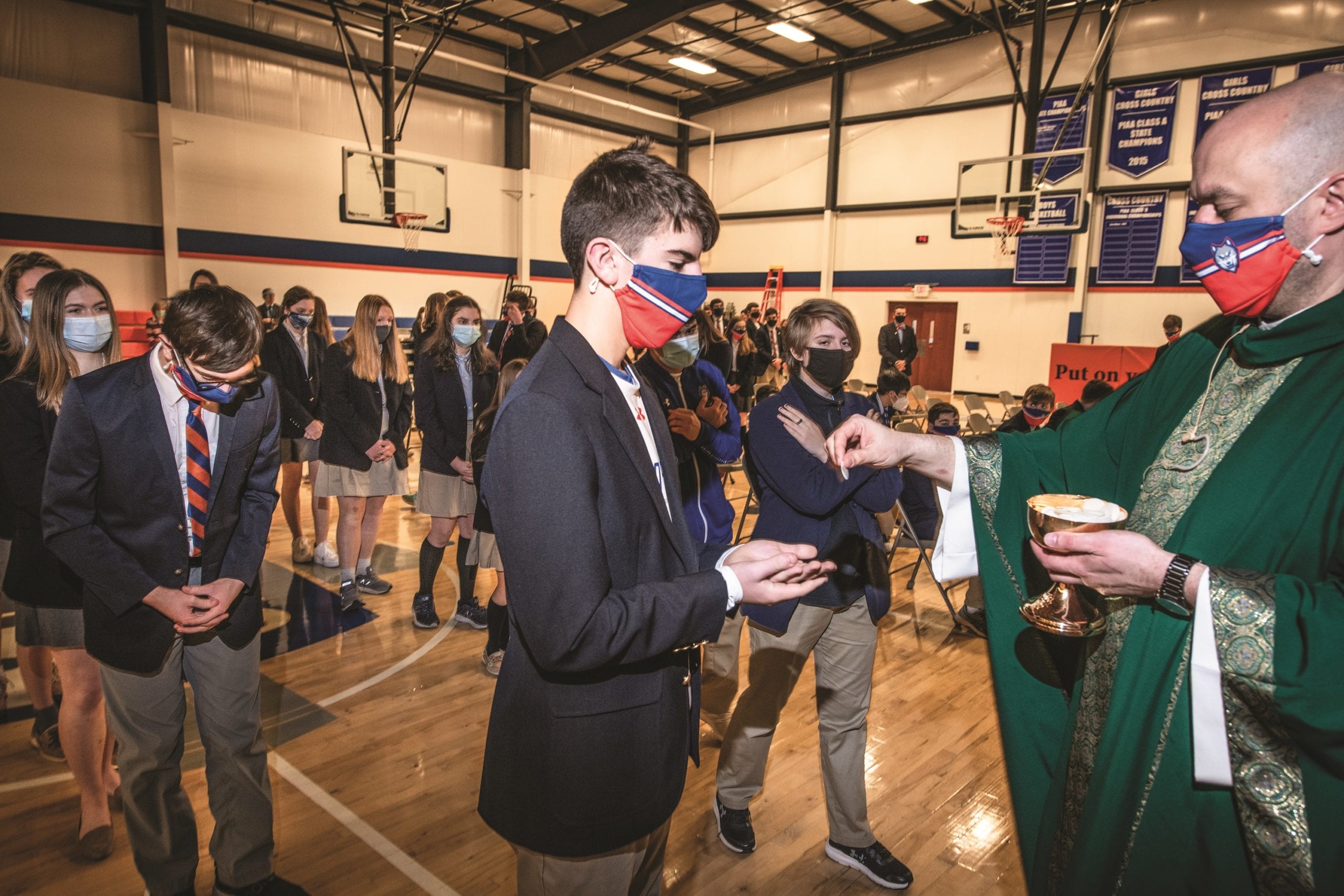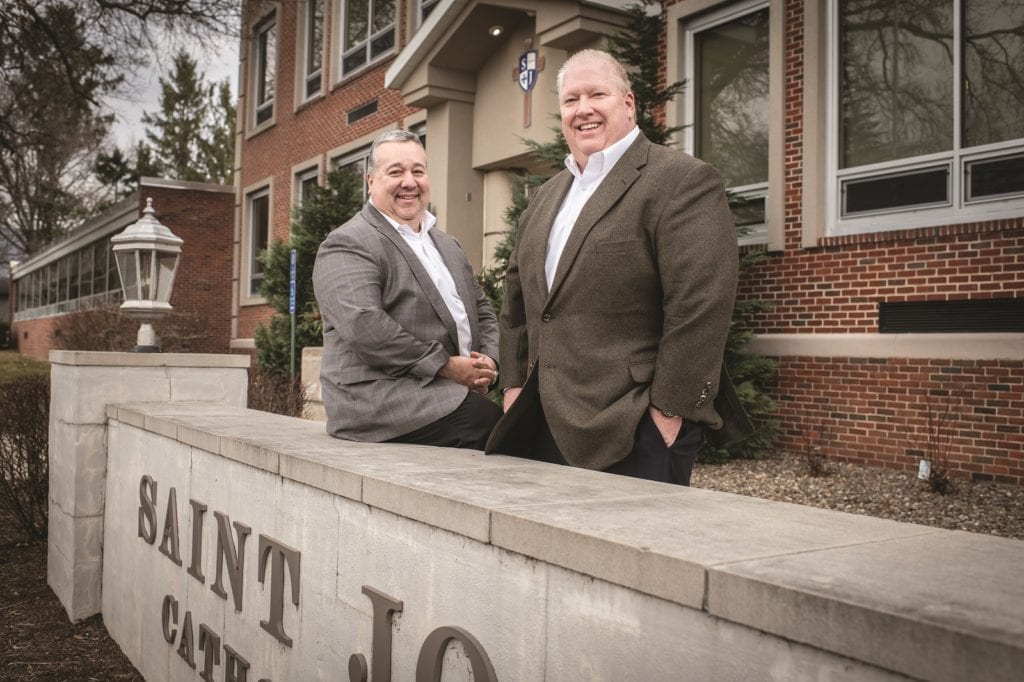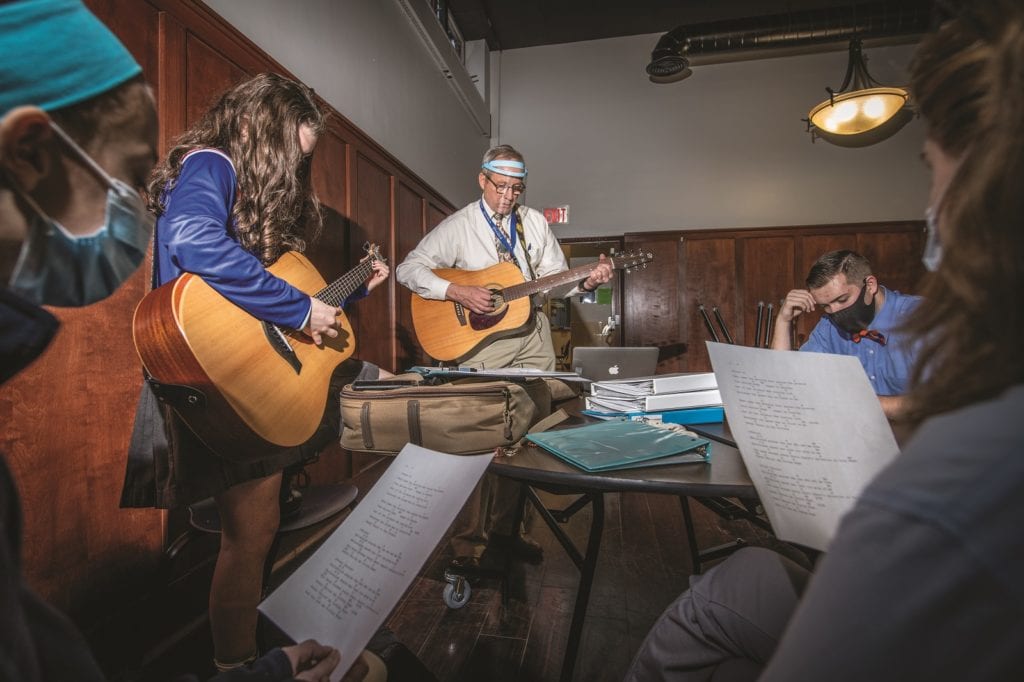
Mass at Saint Joseph's Catholic Academy. (Photos by Darren Andrew Weimert)

Mass at Saint Joseph's Catholic Academy. (Photos by Darren Andrew Weimert)
When Kathy and Jeff Peters were first exploring the idea of moving to State College for Jeff’s job, they were dismayed when their real estate agent informed them that the local Catholic school, Our Lady of Victory, offered only an elementary school education.
“My oldest son, Michael, was an infant, and I remember pausing and thinking, ‘How can we move to a community where the Catholic school ends at middle school?’” Kathy says.
A group of local business leaders – Rob Thomas, Rob Shearer, Sam Malizia, and Mark Shelow – realized there were many other families like the Peters: local parents who wanted a Catholic-based K-12 education for their kids. So, approximately 15 years ago, the group approached the Bishop of the Roman Catholic Diocese of Altoona-Johnstown with their vision of bringing a Catholic high school to the State College area.
Today, Saint Joseph’s Catholic Academy in Boalsburg is celebrating its 10th anniversary. The Peters’ infant son, Michael, was a member of the school’s first four-year graduating class. It took strong leadership, dedication, vision, and perhaps a little divine intervention to get to this point.
Laying the foundation
Getting a new private school off the ground is no small task. Before the Diocese could even approve a new school, the original board members had to dedicate a lot of time and effort to feasibility studies, demographic studies, fundraising, searching for a location, developing a curriculum, and hiring faculty and staff.
“We were juggling a lot of stuff,” says Thomas. “We knew a faith-based high school that was able to offer PIAA sports, a strong curriculum, and smaller classrooms was going to appeal to many families, but we had to create awareness. We did a lot of ‘road shows,’ where we went to different places or hosted people in our homes, just to bring people into the fold and explain what we were doing.”
“Lots of people said, ‘Why do this?’ and ‘How are we going to compete with State High?’” says Shearer. “And of course, we’d say, ‘That’s not the intention.’ We had a feeling that there was a desire for a faith-based school. All of the board members were products of a Catholic education at some point in their lifetime. There’s something different about that environment. And we wanted that for our kids and for our community. And also, a smaller school is sometimes better for students.”
With no experience in school administration, the original board members knew they had to find some qualified help.
“The first big investment we made was to hire a head of school, Doug Bleggi, who had been a school administrator his whole life, had a PhD in education, and he helped build the curriculum. In fact, he was on board for a year and a half before the school opened,” Shearer explains.

The school also needed a physical location, and the founders feared it could take many years to raise enough money to afford the kind of facility they believed would serve their needs. This is when divine intervention stepped in, Shearer says.
“I’ll never forget the day Rob (Thomas) called me and said, ‘You’re not going to believe this, but the school district is selling Boalsburg Elementary School, plus the six or seven acres of land that goes with it.’ And the price was very right, something we could actually already afford,” he says. “We were thinking we were going to have to raise $10 [million] to $12 million, and we probably wouldn’t even have been able to open until 2015 if we had to wait to do that. So we advanced the start date by a few years through that little blessing for sure.”
The building, which was closing as the State College Area School District was opening the new Mount Nittany Elementary School, was in need of updates, Shearer says.
“We were able to buy the building for a decent price and put about the same amount into the renovations,” he says. “We had a great contractor, Chris Kunes, and his company did a terrific job to make the place look like an academy. It’s not a sterile kind of environment. It’s just beautifully done. … So when the students came in, they came into an environment conducive to learning and conducive to community.”
Improvements and upgrades continued over the years, with a large donation earmarked for upgraded science labs in the school’s second year, thanks to Scientific Systems and Andrew Charney, and the addition of the Rob and Alice Thomas Student Life Center in 2015.
“That was a really major milestone in the evolution of the school community,” Shearer says. “It’s a beautiful gymnasium. We have our Masses there. We have a lot of events there. … It’s become a real focal point for students and their families.”
The four pillars
Of course, it takes more than a physical building to create a successful school. The board members knew they would need a strong philosophy, too.
From the beginning, the board identified a philosophy of four pillars that it wanted its school to be based on – faith, scholarship, leadership, and service. The four pillars have remained at the heart of the school’s mission ever since.
Each school year, the school devotes an entire day to each pillar, offering school-wide retreats, workshops, and opportunities for service. They also intentionally incorporate each pillar into daily school life.
According to Laura Cunningham, who has been teaching at Saint Joseph’s for nine years and also serves as the school’s marketing director, “Those four pillars really drive what we do. We have our curriculum and our objectives, but everything is rooted in those four pillars. … I think our students have bought into those four pillars, and they understand that that’s really at the core of what drives us as a school.”
As a Catholic school, it is not surprising that the first pillar listed is always “faith.” On a daily basis, the students practice their faith with morning prayer, and attend weekly Mass and chapel services. The students also begin each school year with a one-day faith-based retreat.
“Faith is who we are; it is part of our identity as a Catholic school and what really drives us,” Cunningham says.
“We’ll never deny the criticality of the faith-based piece of this,” says Thomas. “To see these young people flourish, not only academically and personally, but in their faith journey as well, is something you just don’t see everywhere. It’s tremendously rewarding to be a part of that.”
Still, the school welcomes non-Catholic students, and in fact, about 25 percent of students are not Catholic.
“That’s in line with the national average at Catholic schools,” Thomas says.
It is easily apparent that the second pillar, scholarship, plays an essential role in a Saint Joseph’s education, as well. For one thing, the school boasts an incredible 100 percent college acceptance rate for every graduating class over the past decade, with alumni attending prestigious universities including Notre Dame, Rochester Institute of Technology, Boston College, Johns Hopkins, Duke, and many more. The school has also produced a National Merit Finalist and several Commended Students in the National Merit Scholarship Program.
This is not just a happy accident. The school is very intentional about preparing its students for college and their future careers. For most schools, a 100 percent college acceptance rate would be an exception, but for Saint Joe’s it is expected and just part of the culture.
“Freshman year they come in and take an assessment that gauges their interests and looks at potential career paths. Sophomore year, in a non-COVID year, they’d go job shadow for a day. Junior year, we focus on pre-college entrance exams. Senior year, every student is required to come in on Day One with their common app essays for college, so they have drafts that are very intentionally workshopped,” Cunningham explains. “They apply to a lot of colleges. Our career counselor sits down and works with them one-on-one. I think all of those steps are very purposefully done to help make these students successful.”
Michael Peters attended Rensselaer Polytechnic Institute in New York after graduation, majoring in computer science. He recently accepted a job with Epic Systems in Wisconsin.
“Saint Joe’s definitely prepared me well for college,” he says. “They did a good job at prepping us for the SATs, they spent a lot of time helping us apply to colleges, and they offer a lot of AP courses.”
His sister, Elizabeth, graduated from Saint Joseph’s in 2020. Currently a journalism student in the Wood Honors College at Shippensburg University, she says, “Mrs. Cunningham had us write a literature review our junior year and kept saying, ‘You’re going to have to write one of these in college,’ and lo and behold, I walk into my freshman seminar, and we’re writing a lit review. I remember sitting on my bed at Shippensburg thinking, ‘Wow, I was really well prepared for this.’”
As far as the third pillar, leadership, Elizabeth says, “Saint Joe’s really focuses on the idea that everyone is capable of leading; they don’t just encourage people who are natural born leaders.”
The leadership pillar is largely fulfilled through opportunity – and a small school (Saint Joe’s population averages around 130-160 students) affords plenty of opportunity.
“One of the very significant benefits for kids who come to Saint Joe’s is the ability to participate because it’s a smaller school. We have 11 PIAA sports. So you don’t have to be the premier baseball player to play on the baseball team, for example,” says Shearer. “And it’s not just sports. Every kid is doing multiple activities. You can be an artist, you can do an art show, you can be in the musical, and you can also play basketball.”

One of the biggest leadership opportunities is the Student Ambassador program, explains current Head of School Jennifer Mallett. “I have 24 ambassadors who have responsibility for all things that would be outreach,” she says. “Tours, visitors, open houses or activities, graduation, they’re there. They have a big responsibility. It’s a great leadership opportunity for them.”
“I hear them outside my door when they’re giving a tour, and I’m just blown away at their maturity and their ability to maintain eye contact and carry on intelligent, real conversations with these families,” Cunningham adds. “They’re our best assets to really represent this school. … They’re pretty phenomenal.”
A mentor program that pairs incoming freshmen with upper-class students also gives students an opportunity to hone their leadership skills while helping to build a sense of community amongst all students.
“It’s a nice way for the underclassmen to have someone to turn to if they’re struggling in a class or they don’t know where to turn for a question about the school in general. It’s just kind of a nice support system so they don’t get lost in the mix or feel overwhelmed in the craziness of high school,” Cunningham says.
Leadership opportunities often blend into the final pillar, service. For example, this year the school ambassador program sponsored two needy families over the holiday season, providing them with gift cards, Christmas gifts, and meals.
The school requires each student to complete 25 mandatory service hours per year, and hosts a school-wide annual service day, which most recently has focused on helping to maintain the grounds and exterior of the nearby Boal Mansion property.
Culture of community
When asked about what they appreciate most about the school, parents, students, board members, and staff members alike are all pretty consistent. The school’s small size and the tight-knit sense of community are always near the top of the list.
In a practical sense, that small size allowed the school to adapt easily when COVID-19 shut down schools in the spring of 2020.
“When you’re small, sometimes you’re nimbler,” Shearer says. “We had the ability to be very flexible as far as being able to use technology in a very robust way, so we were able to do things very early on that would be harder for a larger school to do. In fact, Saint Joe’s has been using ‘virtual days’ for snow days since 2011.”
Besides the academic and extracurricular benefits of a small school, Shearer says, “There is no hiding here. There are no strangers here. Your teachers know you; they have the time to say, ‘Hey, what’s going on with you today?’ They get to know your mom and your dad and your brothers and sisters.”
“From the teacher’s perspective, we celebrate one another’s milestones, and we’re there for each other in times of need. … That creates a really cool and special environment for the kids because they learn from us; they see the relationships we are modeling for them,” Cunningham says.
“After every single class that I teach, I have students that thank me for teaching class. They will come up to me, look me in the eye, and say, ‘Thank you for today, I appreciate you teaching.’ That just doesn’t happen everywhere. That’s not required. But they do it. They do it because they care, and because they see us thanking and engaging with each other in a certain manner. And I think that’s truly special.”
Mallett had been working as the principal for eight years at a Catholic high school in Ohio when the Saint Joe’s board reached out to her to interview for the position of head of school in 2018.
“I wasn’t looking for a change, but the first thing that really sold me was the board of trustees. They legitimately care about the school and want it to succeed, and are 100-percent supportive,” she says. “The second thing that sold me is, I sat down and had lunch with some of the kids just to hear what they had to say about Saint Joe’s. … I really wouldn’t have come to a state I had only driven through on the way to somewhere else had it not been for the love of the place that the students and the board had.”
What lies ahead
At 10 years old, Saint Joseph’s is still considered to be new.
“It takes 12-plus years for a new Catholic high school to be established in a community. Technically, we’re still not there,” Thomas says.
But that is a positive thing, Mallett says.
“To have a new school opening up, especially at a time when Catholic schools are not opening, but on the contrary, consolidating or closing – that is really exciting,” she says.
It does, however, pose some challenges for a school that relies solely on tuition dollars and donations to survive.
“From a financial standpoint, when you look at established Catholic schools, a lot have been around for more than 100 years, so their alumni base is a significant resource. Our alumni base is just entering the workforce. So we don’t have that to draw upon. That’s a significant thing we have to overcome every year,” Shearer says.
The school has come to rely heavily on fundraising events such as a formal gala event held each fall, and a golf outing held in the spring. Like most nonprofit organizations, their fundraisers were canceled in 2020. But with the addition of a new director of development last summer – Susan Robinson Fruchtl, who most recently served as director of athletics at Saint Francis University – the school has found new methods of outreach and fundraising.
“Susan kicked off a new Annual Fund, and that has in all ways exceeded the gala, because she’s been able to reach out beyond the people we would normally reach for the gala,” Mallett says.
The founders that started this venture more than 10 years ago remain deeply involved in the school.
“It was definitely a personal mission to start the school. To see it grow and continue to be sustainable throughout many years in this area is very important to me,” says Thomas. “I can’t tell you how many families have approached me over the years – and we’re not looking for thanks, but – thanking us that they have this school, and how wonderful it’s been for their family to have this option in the State College area, to be able to be part of sports, be part of the Drama Club, have Mass each week, be able to celebrate Christmas and Easter during school, and pray each morning and before each sporting event. It’s important for many families, so to be able to continue that mission is very important to me.
“If the next 10 years is like the last 10 years in what we’ve been able to do for many families and the feedback we’ve gotten, then heck – I’m all in.”
Shearer agrees.
“I can’t imagine doing something more fulfilling on a personal level than this. As long as I’m of value to the school, I’ll be around until I’m getting in the way.”
***
This story is part of a special section in the February edition of Town&Gown celebrating 10 years of Saint Joseph’s Catholic Academy. The section is a cooperative effort produced by Town&Gown and SJCA.
Karen Walker is a freelance writer in State College.
Receive all the latest news and events right to your inbox.

80% of consumers turn to directories with reviews to find a local business.